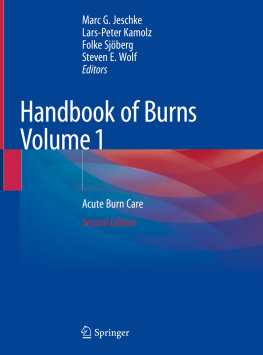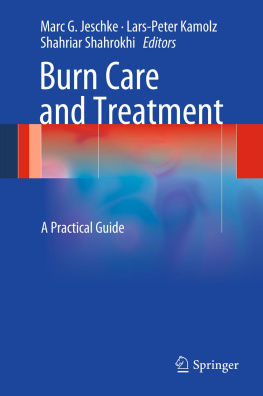Editors
Marc G. Jeschke
Ross Tilley Burn Centre Sunnybrook Health Sciences Centre, Toronto, ON, Canada
Lars-Peter Kamolz
Division of Plastic, Aesthetic and Reconstructive Surgery, Department of Surgery, Medical University of Graz, Graz, Austria
COREMED- Centre for Regenerative Medcine, Joanneum Research Forschungsgesellschaft mbH, Graz, Austria
Folke Sjberg
Department of Clinical and Experimental Medicine, Linkping University, Linkping, Sweden
Steven E. Wolf
Department of Surgery, University of Texas Health Science Center, San Antonio, TX, USA
ISBN 978-3-030-18939-6 e-ISBN 978-3-030-18940-2
https://doi.org/10.1007/978-3-030-18940-2
Springer Nature Switzerland AG 2020
This work is subject to copyright. All rights are reserved by the Publisher, whether the whole or part of the material is concerned, specifically the rights of translation, reprinting, reuse of illustrations, recitation, broadcasting, reproduction on microfilms or in any other physical way, and transmission or information storage and retrieval, electronic adaptation, computer software, or by similar or dissimilar methodology now known or hereafter developed.
The use of general descriptive names, registered names, trademarks, service marks, etc. in this publication does not imply, even in the absence of a specific statement, that such names are exempt from the relevant protective laws and regulations and therefore free for general use.
The publisher, the authors, and the editors are safe to assume that the advice and information in this book are believed to be true and accurate at the date of publication. Neither the publisher nor the authors or the editors give a warranty, expressed or implied, with respect to the material contained herein or for any errors or omissions that may have been made. The publisher remains neutral with regard to jurisdictional claims in published maps and institutional affiliations.
This Springer imprint is published by the registered company Springer Nature Switzerland AG
The registered company address is: Gewerbestrasse 11, 6330 Cham, Switzerland
Preface
Severe burn injuries are maybe not the most common injuries occurring on a daily basis; however, it is estimated that within North America approximately 300,000500,000 patients are hospitalized annually due to a burn-related injury and that worldwide approximately 500,0001,000,000 people die due to a burn-related injury. Once a burn injury has occurred, it is one of the most severe forms of any injury, inducing a complex cascade of various responses including inflammatory, hypermetabolic, immune, as well as infectious responses. These responses interact with each other and are extremely complex and difficult to treat. Specialized centers, protocolized treatment, multicenter trials, and close collaborations improved morbidity and mortality after severe burn injury over the last two decades. However, a vast morbidity and mortality postburn still occurs and represent one of the major problems in burn treatment.
One of the major characteristics of burn injury that has been evolving over the last decade is that a burn injury is not treated and healed once the wounds are healed. This used to be a landmark that no longer exists. Various studies have indicated that a burn injury and its pathophysiologic sequelae persist for at least 510 years, not only in terms of scarring, infection, metabolism, and various other responses. Therefore, this leads to the importance of the current two volumes of these burn books. It has been speculated and hypothesized that early intervention and alleviation of these detrimental responses benefit in terms of clinical outcomes; therefore, the individual book chapters focus on the treatment and complexity of each of these responses to improve outcomes.
We reedited and worked over the two books to include novel aspects of burn. We now focus more on quality of life, on mental health, and on novel technologies. The up-to-date chapters provide evidence-based medicine and current state-of-the-art treatments for any practitioner dealing with acute burn wounds, chronic burn wounds, and all other types of burn wounds. The second volume will then delineate the importance for long-term treatment as it describes the reconstructive and alternative approaches of long-term treatment postburn.
This is unique and therefore will hopefully improve the outcome of burn patients by guiding various kinds of burn practitioners from nursing, physicians, occupational therapy, physical therapy, pharmacy, and so forth. The focus of each chapter is not only to give an overview but also to summarize current best treatments and to make it easy for each reader to easily access the treatment options and knowledge.
We hope that these books will raise as much enthusiasm as it has for its contributors.
Marc G. Jeschke
Lars-Peter Kamolz
Folke Sjberg
Steven E. Wolf
Toronto, ON, Canada Graz, Austria Linkping, Sweden San Antonio, TX, USA














